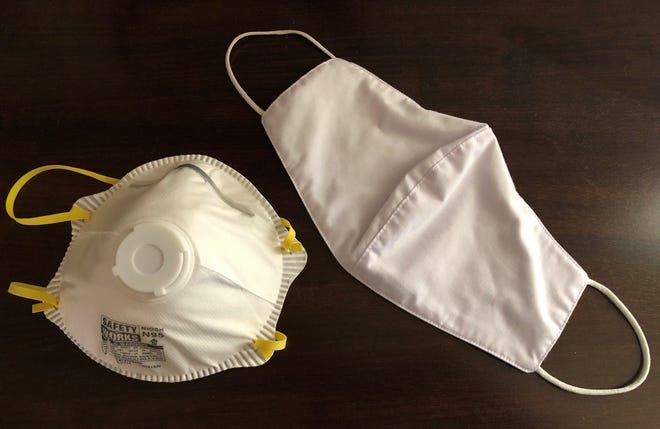NMSU, NMDA experts offer advice on conserving pest control safety gear during COVID-19

LAS CRUCES - During the current COVID-19 pandemic, there is a massive ongoing need for gloves and N-95 masks for medical and health care workers. At the same time, pest management is one of many other fields that also have strict safety requirements necessitating the use of personal protective equipment.
To help address this problem, Leslie Beck, an assistant professor and Extension weed specialist at New Mexico State University, and Stephen Baca, New Mexico Department of Agriculture pesticide compliance section program manager, have co-authored a Cooperative Extension Service publication discussing personal protection equipment during the COVID-19 pandemic.
Their paper, available at https://aces.nmsu.edu/pubs/_a/A618.pdf, emphasizes the importance of wearing the correct PPE while using pesticides, as well as suggestions on how to prolong the usability of equipment in short supply while still following the label requirements.
Beck said there’s been a lot of information going around about do-it-yourself PPE to wear while shopping or going outside to do essential tasks, but she wants people to understand that there are no do-it-yourself equivalents when it comes to applying pesticides.
“There are specific types of PPE that are mentioned in the directions of the label that you must use for safe applications,” Beck explained. “If you use anything else, you are in direct violation of the label and will ultimately compromise your safety when making applications. If the label-required PPE is not available for the application, you might consider alternate pesticides that will still effectively control the pest, but without the label requirements of that specific PPE.”
What's happening at NMSU? Stay informed with a subscription to the Sun-News.
Depending on the pest being targeted, pesticides might include fungicides, insecticides or herbicides. Since N95 respirator availability is very limited outside of medical personnel, opting for a different pesticide that does not require a respirator may give applicators a bit of wiggle room to control pests and still be compliant with the label directions. There are also ways to safely increase the longevity of certain PPE during a shortage.
“The important thing is to increase the longevity as much as possible, while at the same time maintaining its safe protected status,” Beck said. “You want to make sure that if you are rinsing something out, such as a reusable chemical cartridge respirator, that you are not bagging it up for storage when it’s wet, causing it to develop mold. You also want to store PPE separately to limit cross-contamination, and keep it out of direct sunlight to prevent UV degradation.”
Label requirements for some pesticides may specify that the area that has been sprayed can only be accessed by someone wearing a respirator up to 24 hours following the application. Beck suggests limiting the number of times a person can enter the area to further preserve the use of your respirator and maintain safety.

Along with the mask shortage, a disposable glove shortage is also ongoing.
“With pesticides, you can avoid having to use disposable gloves and utilize non-disposal gloves,” Baca said. “They’ll be thicker and heavier duty, but you can clean them and store them and not have to throw them away following every application.”
Beck said it’s also important to follow label directions to make sure you are using the recommended type of glove that will keep you safe when applying the pesticide, such as water-resistant vs. chemical-resistant gloves. Additionally, you’ll want to take proper steps to minimize the spread of contaminants with gloves that are being used for multiple applications.
“In no situation should you be taking off your gloves and just throwing them in the back of your truck as you go from one location to the next,” Beck said. “You need to wash your gloves with soap and water prior to taking them off, and wash your hands following removal before you get into your truck so you're not spreading contaminant on the steering wheel or anywhere else. And you certainly don't want to take off your gloves, put them in your pocket, and forget about them until you get home to change. Proper care and storage will keep you safe and help to prolong the life of your gloves during a shortage.”
Just like the respirators, Beck said to make sure the gloves are dried before you store them to prevent mold. She also suggests storing them in a dry plastic container to keep them away from other equipment and PPE, and out of direct sunlight.
To avoid having to use PPE in the first place, both Beck and Baca suggest integrated pest management strategies.
“We suggest staying ahead of the game, so you use pesticides as a last resort,” Beck said. “Using multiple tools and practices specific to your target pest will help improve pest management success and sustainability over time.”
“Eye on Research” is provided by New Mexico State University. This week’s feature was written by Melissa Rutter of Marketing and Communications. Melissa Rutter can be reached at mrrutter@nmsu.edu.
More from NMSU: